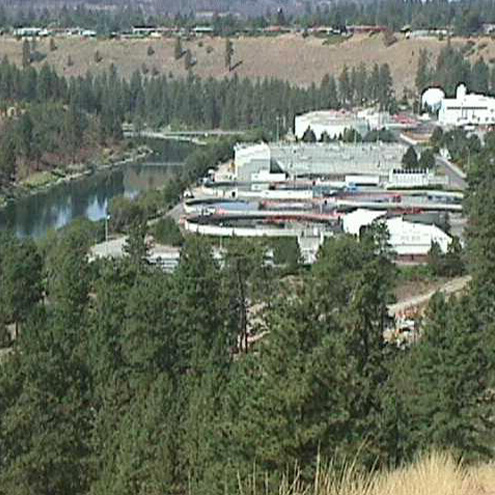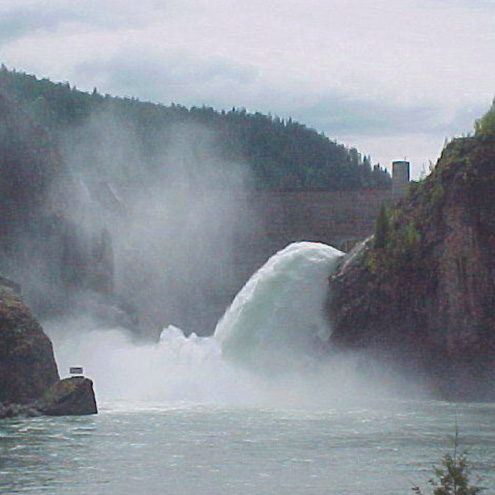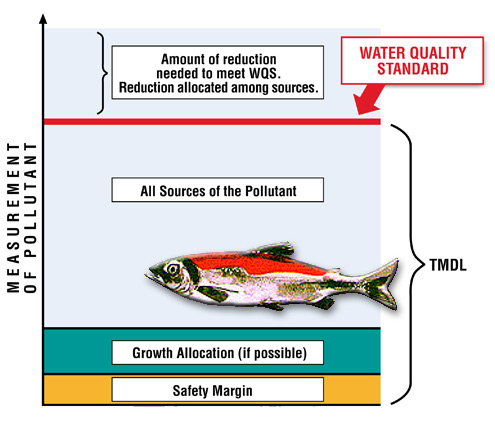-
 1. Learning About TMDLs
1. Learning About TMDLsHey there, I'm Salmo, a kokanee salmon. I'm from a family of fish called salmonids and I live in Lake Roosevelt. The Forum asked me to help explain what Total Maximum Daily Loads (TMDLs) are.
By the end of this slide show, I'll help you learn about TMDLs, why they are important and how they are determined. You'll also learn what TMDLs are being developed for Lake Roosevelt, and how they may affect you .... and me!
To start with, when ever I say TMDL think Water Improvement Plan. Ok ... -
 2. What are TMDLs?
2. What are TMDLs?TMDLs stand for Total Maximum Daily Loads. A TMDL identifies the amount of pollutant a water body can receive and still meet water quality standards for drinking, swimming, fisheries and other uses.
Because there is more than one pollutant that can affect water quality, there can be more than one TMDL for each water body. For each TMDL, an "allocation" is given for how much can safely be in a water body.
That's a mouthful, so let's swim through this slowly. -
 3. The Story of TMDLs
3. The Story of TMDLsThe story of TMDLs dates back to 1972, which is when the Clean Water Act was passed by Congress. I wasn't around back then, but the events that lead to the passage of this law were pretty major. One thing was a huge fish kill that occurred on Lake Erie, one of our largest fresh water lakes. Another big jolt was when the Cuyahoga River, which runs through Cleveland Ohio, caught fire because of all the oil and toxic chemicals that had been dumped into the river. These dramatic events added to a growing awareness and a widespread conviction among the public and Congress that we needed to clean up pollution in our country's rivers, lakes and streams.
-
 4. The Clean Water Act
4. The Clean Water ActThe Clean Water Act was passed to "restore and maintain the chemical, physical, and biological integrity of the Nation's waters." It calls for the "discharge of pollutants into the navigable waters [to] be eliminated" and sets an interim goal for "fishable and swimmable" water. That's a goal that sounds pretty good to me, even if I am a fish!
Setting TMDLs is part of implementing the Clean Water Act. -
 5. Cleanup Efforts
5. Cleanup EffortsThe government's first priority was to focus cleanup efforts where waste was being dumped right into a waterway. This is known as point source pollution and the waste is called effluent. States worked with companies, cities and towns to treat their effluent, issuing what are called National Pollutant Discharge Elimination System (NPDES) permits. The treatment plants and permits reduce the amount of effluent (point source) pollution to lower and safer levels. Photo shows Spokane Wastewater Treatment Plant.
Focusing on NPDES permits for 30 years generally improved water quality, and in some systems significantly! -
 6. Point Source Pollution
6. Point Source PollutionIn Lake Roosevelt, the biggest source of point source pollution has been from smelter, fertilizer, and pulp operations upstream in Canada. Although these sources were contained in the early 1990s, their waste still remains in Lake Roosevelt's sediments.
Current examples of point source pollution include an electric generating station at Kettle Falls, a plywood mill near the Kettle Falls Marina and the Spokane Wastewater Treatment Plant, which places effluent in the Spokane River (a major tributary to Lake Roosevelt). Each of these sources has an NPDES permit. -
 7. Non-point Sources
7. Non-point SourcesFocusing on point source pollution, however, has not been enough to achieve the nation's water quality goals. A big reason for this is because non-point sources of pollution have not been as successfully regulated or controlled.
Non-point sources of water pollution result from things like sediments, chemicals, toxics, debris and other pollutants entering our waterways from widely dispersed sources. For instance, rain water and melting snow pack can transport and deposit pollutants to a waterway near or far away. Changes to the water's chemistry, like temperature or gas, can also be considered a non-point pollution source.
For a species like me, the water conditions that affect my health can be caused by activities close or far away from home. -
 8. Total Dissolved Gas & Temperature
8. Total Dissolved Gas & TemperatureOn Lake Roosevelt, two of the most common kinds of non-point pollution are total dissolved gas and temperature. These sources are mostly caused by upstream hydropower operations (Boundary Dam shown in photo). TMDLs for both are currently being developed. Please see my slideshows on Temperature TMDLs and Total Dissolved Gas TMDLs for more information!
Erosion from banks slumping is another source of concern, as are things like forestry, grazing and farming practices. And particularly at the southern end of the lake, new developments mean we need to pay close attention to things like septic tanks and road construction.
I also have a message for the up to 1.5 million people who boat and camp around the lake. If you dispose of your waste and maintain your equipment properly, it's nice having you around. If you don't, you're a non point source of pollution that can be hazardous to our health. -
 9. Impaired Water Bodies
9. Impaired Water BodiesTo describe the scope of the situation nationally, here are some numbers. Over 40% of our water bodies still don't meet the Water Quality Standards set for them. This amounts to over 20,000 individual river segments, lakes, and estuaries. These impaired waters include approximately 300,000 miles of rivers and shorelines polluted mostly by sediments, excess nutrients, and harmful microorganisms.
That's enough miles to travel around the world twelve times!!! Chances are you live within 10 miles of one of these impaired water bodies, 218 million people do. -
 10. Addressing Water Quality Standards
10. Addressing Water Quality StandardsUsing TMDLs to address water quality standards is fairly new. Back in 1986, conservation groups around the country began taking legal action against the Environmental Protection Agency (EPA). The law suits charged that EPA wasn't implementing all the requirements of the Clean Water Act, in particular TMDLs.
By 2001 there were some 40 different law suits in 38 states related to TMDLs. That prompted EPA, and subsequently Washington and other states, to develop guidance for the TMDL program just a few years ago. That is why you are hearing more about TMDLs now.
In Washington, over 600 water bodies need TMDLs by 2013. -
 11. Water Quality Standards
11. Water Quality StandardsIn Washington, the Department of Ecology works with tribes, local governments, interest groups and the general public to determine how they want to use their water. For example, do they want to use it for drinking water, industrial uses, recreation, irrigation, and/or fish and wildlife? These are called beneficial uses.
Then they work with these groups to set up Water Quality Standards to assure water can safely support these uses. Any water bodies that don't meet the Water Quality Standards are called impaired and the State or Tribe puts these on a 303(d) list, which shows specifically which standards aren't met. The list is called 303(d) because it comes from that section of the Clean Water Act.
The list is then prioritized, TMDLs developed, and an implementation strategy agreed upon. Then strategies are implemented and monitored for effectiveness. -
 12. Allocations
12. AllocationsTo sum it all up, a TMDL is a water improvement plan. It identifies, using scientific methods, the amount of a specific pollutant (from a point or non-point source) that a water body can receive and still meet Water Quality Standards.
In determining this scientists may also add into the equation allocations for impacts anticipated by future growth in pollutant sources (Growth Allocation), and an allocation for scientific uncertainty (Safety Margin).
An allocation is just a portion or a share of the whole amount. Kind of like divvying up a pizza ... or a swarm of zooplankton in my case. -
 13. TMDL Allocations
13. TMDL AllocationsExperts then determine how much pollutant needs to be reduced from various sources to meet water quality standards. Responsibility and allocations are assigned to both point and non-point sources.
TMDL allocations set a standard to help guide the decision making process of managers. For instance, government and tribal agencies use these standards for deciding permitting and other regulatory requirements.
When the implementation strategies are developed the groups look for the most feasible ways to meet the water quality standards. They determine what changes will be made and where. -
 14. Lake Roosevelt TMDLs
14. Lake Roosevelt TMDLsFor Lake Roosevelt TMDLs are being developed for water temperature and total dissolved gas, both of which are seasonally higher than the water quality standards.
A temperature TMDL (remember water improvement plan) is being developed for the whole Columbia River and the Snake River systems. Lake Roosevelt is the portion of the Columbia that extends from Grand Coulee Dam to the Canadian border.
I've got slide shows about both of these which you should see.
-
 15. Remarkable Coordination
15. Remarkable CoordinationThe coordination that is occurring for these efforts is remarkable! Organizations include the U.S. Environmental Protection Agency (EPA), U.S. Bureau of Reclamation, the U.S. Army Corps of Engineers and other federal agencies, Columbia Basin Tribes (with the Colville Confederated Tribes and the Spokane Tribe of Indians taking the lead for Lake Roosevelt); the States of Idaho, Oregon and Washington; county and city governments; hydropower operators and other industries; and a wide variety of interest groups. Their common purpose is to maximize the beneficial uses of our water ways while protecting water quality standards.
Also remember that the Clean Water Act and TMDLs are a U.S. law. Canada has its own water quality laws and works closely with their U.S. counterparts to address issues of mutual concern. -
 16. Thank You
16. Thank YouWell, thanks for staying with me. I hope this has been helpful. If you'd like to learn more about TMDLs, click on the TMDL Links icon below.






